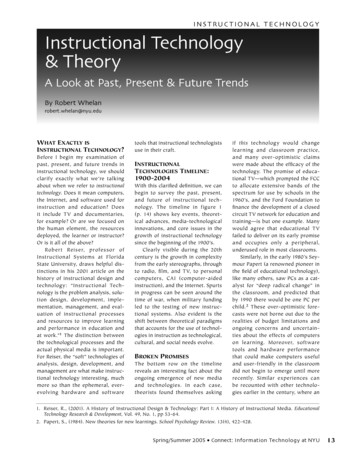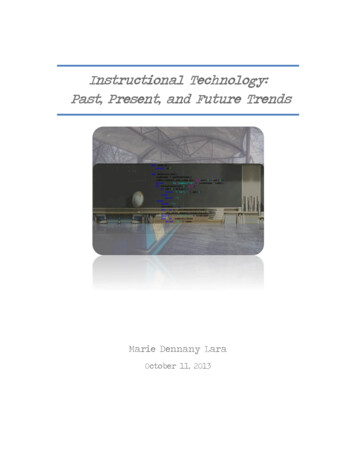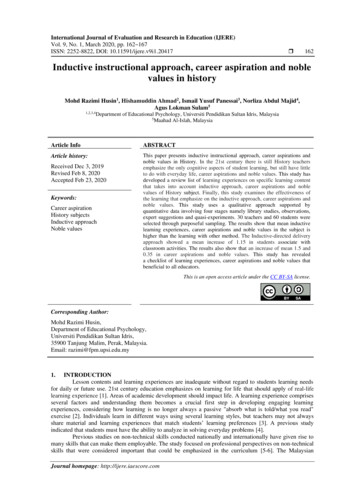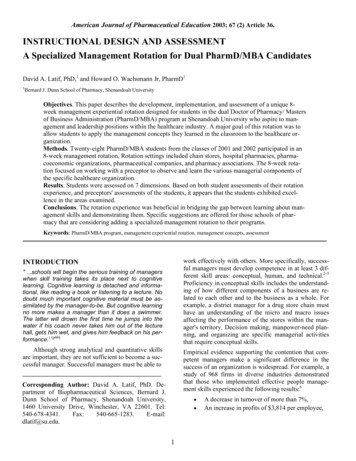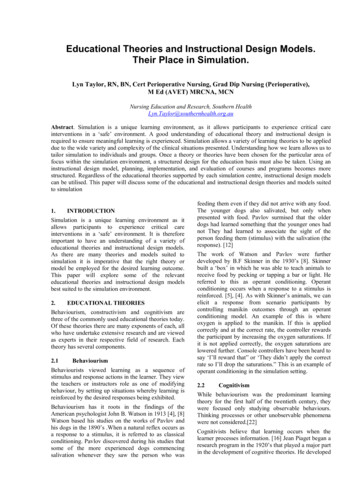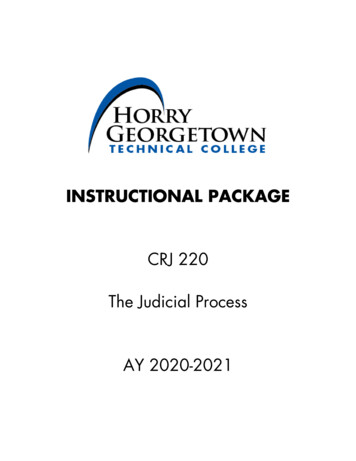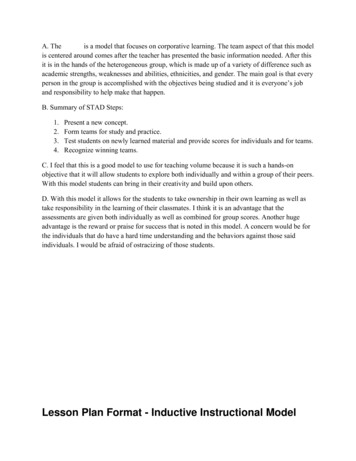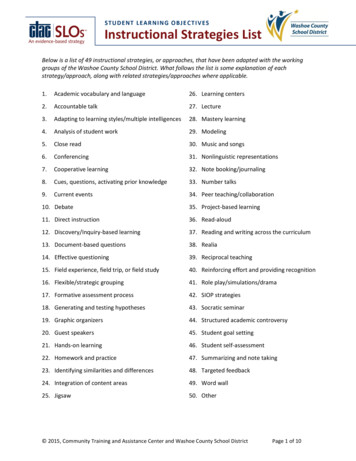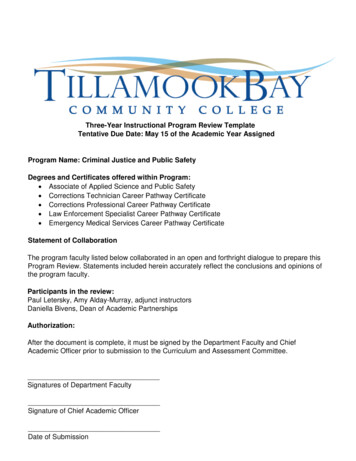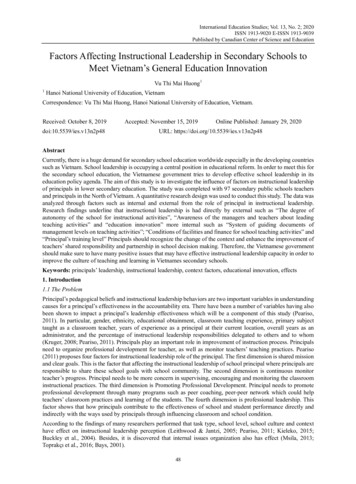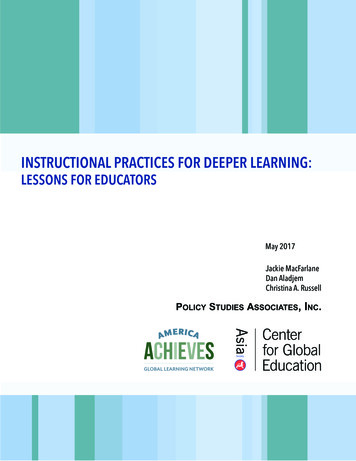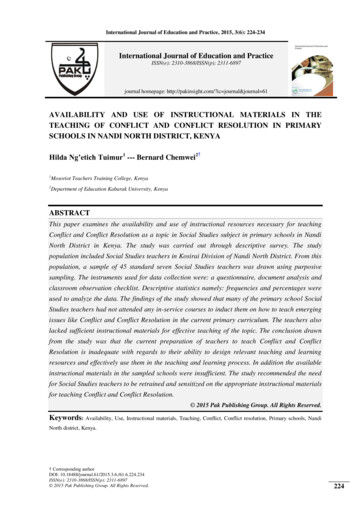
Transcription
International Journal of Education and Practice, 2015, 3(6): 224-234International Journal of Education and PracticeISSN(e): 2310-3868/ISSN(p): 2311-6897journal homepage: http://pakinsight.com/?ic journal&journal 61AVAILABILITY AND USE OF INSTRUCTIONAL MATERIALS IN THETEACHING OF CONFLICT AND CONFLICT RESOLUTION IN PRIMARYSCHOOLS IN NANDI NORTH DISTRICT, KENYAHilda Ng’etich Tuimur1 --- Bernard Chemwei2†1Mosoriot Teachers Training College, Kenya2Department of Education Kabarak University, KenyaABSTRACTThis paper examines the availability and use of instructional resources necessary for teachingConflict and Conflict Resolution as a topic in Social Studies subject in primary schools in NandiNorth District in Kenya. The study was carried out through descriptive survey. The studypopulation included Social Studies teachers in Kosirai Division of Nandi North District. From thispopulation, a sample of 45 standard seven Social Studies teachers was drawn using purposivesampling. The instruments used for data collection were: a questionnaire, document analysis andclassroom observation checklist. Descriptive statistics namely: frequencies and percentages wereused to analyze the data. The findings of the study showed that many of the primary school SocialStudies teachers had not attended any in-service courses to induct them on how to teach emergingissues like Conflict and Conflict Resolution in the current primary curriculum. The teachers alsolacked sufficient instructional materials for effective teaching of the topic. The conclusion drawnfrom the study was that the current preparation of teachers to teach Conflict and ConflictResolution is inadequate with regards to their ability to design relevant teaching and learningresources and effectively use them in the teaching and learning process. In addition the availableinstructional materials in the sampled schools were insufficient. The study recommended the needfor Social Studies teachers to be retrained and sensitized on the appropriate instructional materialsfor teaching Conflict and Conflict Resolution. 2015 Pak Publishing Group. All Rights Reserved.Keywords: Availability, Use, Instructional materials, Teaching, Conflict, Conflict resolution, Primary schools, NandiNorth district, Kenya.† Corresponding authorDOI: 10.18488/journal.61/2015.3.6./61.6.224.234ISSN(e): 2310-3868/ISSN(p): 2311-6897 2015 Pak Publishing Group. All Rights Reserved.224
International Journal of Education and Practice, 2015, 3(6): 224-234Contribution/ OriginalityLearning occurs best when a multiplicity of senses are involved, other than overreliance onverbal communication alone. Instructional materials are quite important for effective teaching ofconflict and conflict resolution. As such, this study contributes in the existing literature ofinstructional technology because there exist a lot of constraints in the effective teaching of SocialStudies and by implication conflict and conflict resolution in Kenyan schools. This study will beuseful to teachers who will carefully select and skillfully handle the resources to make theirteaching effective. Besides they will be able to know the criteria for selecting and evaluatingresources. This study provides information to Ministry of Education on the prevalentpractices/approaches regarding the implementation of the topic (being an emerging issue) in theprimary Social Studies curriculum. It will also provide information on instructional materials topublishers so that they can prepare relevant teaching/learning materials.1. INTRODUCTIONOne important dimension in teacher education that is getting a lot of attention is related to theuse of instructional materials. Instructional materials are those materials used by a teacher tosimplify their teaching. They include both visual and audio-visual aids and could either be concreteor non-concrete.These instructional materials bring life to learning by stimulating students to learn. The use ofinstructional materials in the classroom has the potential to help the teacher explain new conceptsclearly, resulting in better student understanding of the concepts being taught. However, they arenot ends in themselves but they are means to an end (Kadzera, 2006).It is held that good teaching resources can never replace the teacher but the teacher uses themto achieve their teaching and learning objectives. Some of the instructional materials necessary foreffective teaching and learning of Social Studies include the chalkboard, models, graphs, charts,maps, pictures, diagrams, cartoons, slides, filmstrips, radio, and television (Kochhar, 1991). Theimportance of the use of these materials cannot be underscored.This has been emphasized by a number of scholars. Lockheed (1991) says that instructionalmaterials are critical ingredients in learning and that the curriculum could not be easilyimplemented without them.Kochhar (1991) adds that a teacher who has adequate and relevant teaching facilities is moreconfident, effective and productive. Similar sentiments are shared by Steel (1983) who asserts thatrelevant instructional materials enable the learners to have a clear understanding of Conflict andConflict Resolution.Instructional materials are essential since they help the teacher and learners avoidoveremphasis on recitation and rote learning that can easily dominate a lesson. Resource materialsallow learners to have practical experiences which help them to develop skills and concepts and towork in a variety of ways. The work of Sampath (1990) graphically explain that people learn morethrough the senses of sight and hearing compared to other senses. 2015 Pak Publishing Group. All Rights Reserved.225
International Journal of Education and Practice, 2015, 3(6): 224-234Table-1. Percentages of what is learnt using Different SensesSenses used when LearningTasteTouchSmallHearingSightTotal% of what is learnt1.01.53.511.583.0100.0Source: Sampath (1990)Sampath also notes that we remember more when we see, hear, say and do.Table-2. What is remembered from Learning Activities using Different SensesLearning ActivityWhat we readWhat we hearWhat we seeWhat we see and hearWhat we say and do% of what is remembered1020305080Source: Sampath (1990)The implication here is that for more knowledge to be internalized, more of the learner’ssenses have to be stimulated other than hearing alone. In learning and teaching, the various sensescan be stimulated through the use of audiovisual materials. In teaching Conflict and ConflictResolution, the Non-Violence Education Programme asserts that the flip chart teaching tool is astand-alone material that can be used in any classroom without the expense of additional resource.At the same time, Walkin (1982) says that instructional materials have to meet the learningobjectives, be validated and their impact be evaluated. But Jarolimek and Parker (1993) are of theview that instructional materials for Social Studies need to be evaluated carefully before, duringand after they have been used. This is because it is the teacher and not the media who produceexciting programmes for children. As such, apart from being available and adequate, instructionalmaterials should also be used appropriately. No material is entirely self-teaching; they all require ateacher to set the stage for learning to take place because materials of instruction can be no betterthan the teachers who use them. In summary, Romiszowski (1988); Walkin (1982) and Hills (1982)concur on the fact that if instructional materials are properly selected and used, the following wouldoccur: Learning would be interesting and meaningful. Knowledge acquired would be retained for a longer time. Different skills would be acquired by learners. Students would be actively involved during lessons.From the above views, it is clear that instructional materials are essential for effective teachingof Conflict and Conflict Resolution in Social Studies and should be made adequately available inall schools. To help teachers become better teachers, most schools in developed countries areprovided with a variety of instructional materials and equipment. But the situation in Primary 2015 Pak Publishing Group. All Rights Reserved.226
International Journal of Education and Practice, 2015, 3(6): 224-234schools in Kenya is quite different. The Kenya Institute of Curriculum Development (KICD)carried out a summative evaluation of the 8-4-4 in the secondary school curriculum. It emerged thatif learning materials were to be used effectively, then there was need for provision of adequateresources and facilities.Teaching materials needed for inquiry methods are sometimes non-existent and relativelyexpensive when available. Ogoma (1987) in a survey on resources for teaching in Nairobi primaryschools, has found that teachers are not eager to use the available instructional materials or evenproduce them. Komen (1991) in a similar study in Baringo District, found out that instructionalmaterials are inadequate.Similarly, Malakwen (2000) on teacher trainers and trainees’ attitudes towards theimplementation of Social Studies curriculum in Kenya’s Teacher education institutions, noted thatthe materials that trainees use in preparation for teaching practice in primary schools are inadequateand of low quality. Most of these studies on the teaching of Social Studies were carried out beforethe introduction of the new Social Studies Syllabus in 2002. In the new syllabus, emerging issueslike Conflict and Conflict Resolution have been introduced. For these topics to be effectivelytaught there is need to adequately avail and effectively utilize instructional materials. This paper,therefore, assesses the availability and use of instructional materials by Social Studies teachers inprimary schools in Kenya in teaching Conflict and Conflict Resolution.2. STATEMENT OF THE PROBLEMThere have been increasing criticisms on the teaching of Social Studies in primary schools inKenya, especially with regard to the teaching methods and instructional materials. The teaching ofSocial Studies in Kenyan classrooms has been dominated by lecturing and giving of notes,accompanied by use of the chalkboard only and prescribed textbooks (African Social andEnvironmental Studies Programme (African Social and Environmental Studies Programme, 1993).One of the emerging issues included for teaching and learning in the Social Studies syllabus inthe Kenyan primary schools is Conflict and Conflict Resolution.The objective of teaching this topic is to enable the learners to understand the factors that causedisputes and demonstrate the ability and readiness to amicably resolve their own disputes in andout of schools (Kenya Institute of Education, 2002). For this learning objective to be achieved theteacher must select the instructional procedures and materials that will enable the leaner tointernalize, retain and apply what has been learnt.Only then can the learners productively apply what they learn in everyday life. Ogoma (1987)in a study on resources for teaching in Nairobi primary schools, points out that teachers are noteager to use the available resources.Moreover, Komen (1991) observes that instructional materials are inadequate and at the sametime, teachers are not adequately prepared. It was against this background that the study wascarried out to investigate the teaching of the topic on Conflict and Conflict Resolution in SocialStudies in primary schools in Nandi North District in Kenya. 2015 Pak Publishing Group. All Rights Reserved.227
International Journal of Education and Practice, 2015, 3(6): 224-2343. LIMITATIONS OF THE STUDYSince the sample subjects were few, the results may not be generalized to other areas.Nevertheless, the research findings reveal a lot about the current state of teaching methods andmaterials for teaching Conflict and Conflict Resolution in Social Studies and the attitude ofteachers towards these. Moreover, Kosirai Division was in a rural setting hence the findingsobtained may not apply to schools in peri-urban and urban setting. Another limitation had to dowith the fact that since the topic is taught once a year in Class Seven, the researchers had to informthe teachers in advance about the observation of the lesson. As such, they may have prepared wellfor the lesson in order to mask the true picture of the activities of teaching and learning of SocialStudies in their schools.4. MATERIALS AND METHODSThe study was carried out in Kosirai Division, which is part of Nandi North District, in theformerly Rift Valley Province, Kenya. Kosirai is a rich agricultural region where crops like maize,potatoes and vegetables are grown. Dairy farming is also widely practiced. It covers an area of3,784 km2. The Division has three (3) educational zones, namely Mutwot, Lelmokwo, and Kosirai.Educational institutions include forty-five (45) primary schools, twelve (12) secondary schools, one(1) college and other tertiary institutions such as village polytechnics.The research design adopted for the study was a descriptive survey. This kind of research waschosen because it would help reveal answers to questions concerning the current status of theteaching of Conflict and Conflict Resolution in Social Studies at the primary school level withregard to instructional methods and materials and the attitudes of teachers towards instructionalmethods and materials for teaching the topic. It was assumed the findings from the research wouldapply to other primary schools in Kenya because the same Social Studies syllabus is used in thewhole country and the teachers of Social Studies in primary schools in Kenya are trained on how touse different instructional procedures and materials.The target population consisted of primary school Social Studies teachers in Kosirai Division.The teachers were distributed in primary schools across three educational zones in the Divisionnamely, a) Mutwot zone with sixteen (16) schools, b) Lelmokwo zone with fourteen (14) schoolsand c) Kosirai zone with fifteen (15) schools. The sample for the study was drawn from all theStandard Seven Social Studies teachers in Kosirai Division. One teacher was picked from each ofthe 45 schools. Purposive sampling was used to ensure that subjects were picked from Class SevenSocial Studies teachers since they are the ones who do the actual teaching of Conflict and ConflictResolution in class. Most of the schools in the Division had one stream of Standard Seven thus theteacher was automatically selected. Therefore, 45 teachers who taught social studies in class sevenin primary schools in Kosirai Division were used for the study.The instruments used for data collection in the study were: a questionnaire, document analysisand classroom observation checklist. After receiving the completed questionnaires, the author wentthrough all of them to ensure that there were no mistakes in the marking of responses. Open-endeditems were categorized and coded. An item-by-item analysis of the data was done using theStatistical Package for Social Sciences (SPSS) computer program where frequencies and 2015 Pak Publishing Group. All Rights Reserved.228
International Journal of Education and Practice, 2015, 3(6): 224-234percentages were computed. The analyzed data was presented by use of tables and discussed inrelation to the research questions and the reviewed literature so as to draw conclusions and makerecommendations. Information from the teachers’ guides was entered into a document analysischecklist. These were computed to get frequencies and percentages and the results presented intables. Information from classroom observation checklists was coded and the data was analyzedwhere frequencies and percentages were computed and also presented in tables.5. RESULTS AND DISCUSSION5.1. Availability of Instructional Materials for the Teaching of Conflict and ConflictResolutionThe study sought to establish the available instructional materials for teaching and learning ofSocial Studies topics such as Conflict and Conflict Resolution. The results were as shown in Table3 below.Table-3. Availability of Instructional Materials for Teaching Conflict and Conflict Resolution in Social StudiesPupils’ TextbookTeachers’ referenceChalkboardWall mapsAtlasesNewspapersChartsAudio TapesSchool RadioPicturesMagazinesTelevisionNotice boardResource PersonsComputersLocal environmentReal objectsTeacher-made notesYes )38(95)No otal 0)40(100)40(100)40(100)40(100)Table 1 above presents the teachers’ responses on the availability of specified instructionalmaterials. All of the teachers, 40(100%), agreed that teachers’ and pupils’ textbooks, thechalkboard, wall maps, atlases and teacher-made notes were available. The findings furtherrevealed that newspapers were available, according to a low percentage of teachers; 16(40%)agreed and 24(60%) disagreed on this. Inadequate availability of the requisite material may havehindered effective preparation and teaching of Conflict and Conflict Resolution in Social Studies.Conflicts are a part of everyday living. Newspapers update one on conflicts as and how they occurand how they have or have not been resolved. News on conflicts in parts of the country, continentand beyond could guide the teacher when preparing to teach the lesson. 2015 Pak Publishing Group. All Rights Reserved.229
International Journal of Education and Practice, 2015, 3(6): 224-234Regarding charts, 36(90%) indicated that they were available while 4(10%) said they were notavailable. In contrast, for audio tapes 2(5%) agreed while 38(95%) disagreed that they wereavailable. The absence of these resources could be attributed to the lack of electricity in most ruralschools. This may have made the learners miss out on the development of listening skills as well asbringing reality into the lesson thus making the content applicable to their lives. Jacinta and Regina(1992) assert that audio tapes bring reality into the classroom and add interest and enjoyment to thelesson. The school radio was available to 8(20%) of the teachers while 32(80%) said they did nothave it. Pupils should be exposed to radio lessons since they are tailored to provide perfect learningbased on thorough preparation by KIE standards (Jacinta and Regina, 1992). Pictures wereavailable to 28(70%) while 12(30%) gave a negative response. Magazines could be accessed by6(15%) which was a small number compared to 34(85%) who could not access them. This impliedthat the teachers concentrated only on the approved textbooks in their preparation and teachingwhich may not have provided all the information for effective teaching of conflict and conflictResolution. The findings also revealed that the television and the computer were available to only ahandful 2(5%) while 38(95%) had no access to them. This may be explained by the fact thatbecause of the rural setting, there was no electricity in most schools as earlier stated thus thesegadgets could not be used. The teachers seemed to be keen on preparation for their lessons as38(95%) agreed to teacher made-notes. A small percentage, 2(5%), did not have teacher-madenotes and thus may have depended on textbooks only. Schools were generally ill-equipped with theinstructional materials needed for effective teaching of Conflict and Conflict Resolution.6. USE OF INSTRUCTIONAL MATERIALS WHEN TEACHING CONFLICTAND CONFLICT RESOLUTION IN SOCIAL STUDIESTable 4 presents the frequency of use of instructional materials by Standard Seven SocialStudies teachers when teaching the topic on Conflict and Conflict Resolution.Table-4. Frequency of Use of Instructional Materials when Teaching Conflict and Conflict Resolution in Social StudiesMaterialsPupils’ textbooksTeachers’ referencesChalkboardWall mapsAtlasesNewspapersChartsAudio tapesSchool radioPicturesMagazinesTelevisionNotice boardsResource personsComputersLocal environmentReal objectsTeacher-made notesAlways 0(0)12(30)0(0)0(0)6(15)0(0)0(0)2(5)0(0)40(100) 2015 Pak Publishing Group. All Rights Reserved.Occasionally er tal 0)40(100)40(100)40(100)40(100)230
International Journal of Education and Practice, 2015, 3(6): 224-234All the respondents, 40(100%), indicated that they always used pupils’ textbooks and thechalkboard. This implied that the teachers made use of materials that were available as earlierindicated in Table 3.Regarding teachers’ references, 38(95%) indicated that they always used themwhile 2(5%) used them occasionally. On wall maps, 6(15%) indicated they used them always,32(80%) indicated that they used them occasionally while 2(5%) never used them. With regard toAtlases, 14(35%) indicated they used them always, 24(60%) said frequently and 2(5%) never usedthem. As the results in Table 4 show, 22(55%) indicated that they used newspapers always,18(45%) said frequently. This implies that though newspapers may not have been available to someof them, 24(60%), as earlier shown in Table 3, they made an effort to access them for purposes ofteaching Conflict and Conflict Resolution. Newspapers should be made available to all teachers inprimary schools because from these newspapers they could link what they are teaching to everydaylife. The findings further indicated that 8(20%) of the respondents always used charts, 30(75%)used them frequently and 2(5%) never used charts.Majority, 38(95%), of the respondents indicated that they never used audio tapes while 4(10%)frequently used audio tapes. Regarding the school radio, none of them used it always, 6(15%) usedit frequently and 34(85%) never used it. With regard to pictures, 12(30%) indicated that they usedthem always, 18(45%) frequently while 10(25%) never used pictures at all. This is not in keepingwith the fact that one learns 83.0% through sight (Sampath, 1990). Pupils taught by the 10(25%)respondents were therefore disadvantaged. When asked to state the frequency of use of magazines,0(0%) indicated that they used them always, 8(20%) used them frequently and 30(75%) never usedthem. This may be because they were not available to many of the respondents, 34(85%), as earlierindicated in Table 3; or they may have not been sensitized on the use of magazines in teachingconflict and conflict resolution. The study further revealed that none of the respondents used thetelevision 0(0%). According to Sampath (1990) one remembers 50% of what they learn throughsight and hearing. Learners should, therefore, be exposed to different teaching materials.Table-5. Instructional Materials used in Class when Teaching Conflict and Conflict Resolution as observed during theSocial Studies LessonMaterialPupils’ textbooksTeachers’ textbooksChalkboardWall mapsAtlasesNewspapersChartsAudio tapesSchool RadioPicturesMagazinesTelevisionsNotice boardsReal objectsTeacher-made notesComputersLocal environmentYes (00)1(16.6)0(00)0(00)0(00)1(16.6)6(100)0(00)0(00) 2015 Pak Publishing Group. All Rights Reserved.No (100)Total 6(100)231
International Journal of Education and Practice, 2015, 3(6): 224-234The notice board was always used by 6(15%) of the respondents; 10(25%) used it frequentlyand 24(60%) never used it at all. This is another material which seems to have been ignored yet itwas available to 20(50%) of the respondents. Regarding resource persons, none of the respondentsused them always, 22(55%) used them frequently and 18(45%) did not use them at all. All therespondents did not use the computers for teaching Conflict and Conflict Resolution. This mayhave been explained by the fact that the schools were in the rural set-ups where in most cases haveno access to electricity. Another indication is that apart from providing textbooks the governmentshould also provide computers. The local environment was always used by 2(5%), 26(65%)frequently and 12(30%) never. Teachers are encouraged to use the local environment in theteaching of conflict and conflict resolution, only then can the learners see the connection betweenwhat they are learning and the reality. None of the respondents used real objects always, 10(25%)used them frequently while 30(75%) never used them.Table 5 presents the findings on the materials used by teachers when teaching conflict andconflict resolution. This information was collected using an observation checklist. Six lessons wereobserved and these were the findings.As shown in Table 5 above, all of the teachers used the pupils’ and teachers’ textbooks, thechalkboard and notes they made. None of the teachers used wall maps, newspapers, charts, audiotapes, school radio, magazines, televisions, the notice board, computers and the local environment.This may imply that the teachers attempted to use whatever materials were available. There is needfor them to be sensitized on the use of newspapers since through them they could relate the topic toeveryday events to the learners. As indicated in Table 6, all the teachers’ guides recommended theuse of newspapers in preparation and teaching of conflict and conflict resolution. A smallproportion 2(33.3%) teachers used atlases while 1(16.6%) used pictures and exhibits. Most of theTeachers’ guide books recommended the use of pictures when teaching Conflict and ConflictResolution. The teachers did not use them yet they had the teachers’ guides and they may havecome across the information recommending their use. They may have avoided using pictures due tolack of confidence on how to use them and its inadequacy, as earlier on indicated in Table 3 wherepictures were available to only 28(70%) of them.7. INSTRUCTIONAL MATERIALS RECOMMENDED IN THE PRIMARYSOCIAL STUDIES TEACHERS’ TEXTBOOKS ON THE TEACHING OFCONFLICT AND CONFLICT RESOLUTIONTable-6. Instructional Materials Recommended by Primary Social Studies Teacher’s Guides (approved by the Ministry ofEducation) on the Teaching of Conflict and Conflict ResolutionItemPupils’ bookChalkboardWall mapsAtlasesNewspapersYes F(%)6(100)6(100)0(00)0(00)6(00)No F(%)0(00)0(00)6(100)6(100)0(00)Total F(%)6(100)6(100)6(100)6(100)6(100)Continue 2015 Pak Publishing Group. All Rights Reserved.232
International Journal of Education and Practice, 2015, 3(6): 224-234ChartsAudio tapesSchool radioPicturesMagazinesTelevisionsNotice boardsResource personsReal objectsTeachers’ notesComputersLocal 6(100)6(100)6(100)6(100)6(100)With regard to instructional materials, all the teachers’ guides recommended the use of pupils’textbooks, chalkboard and newspapers. A majority, 5(83.4%), recommended the use of pictures.None of the books recommended the use of atlases, wall maps, charts, films, audio tapes, schoolradio, notice board, computers and the local environment. Further analysis revealed that 1(16.6%)recommended the use of magazines, televisions and real objects. From these findings, the teachers’guides used by the teachers of Social Studies gave appropriate guidance to teachers on the teachingof Conflict and Conflict Resolution. However, teachers should be guided on the uses of the schoolradio which helps bring reality into the classroom and contains perfectly designed lessons becauseof the preparations and rehearsals that go into them before presentation (Jacinta and Regina, 1992).8. CONCLUSION AND RECOMMENDATIONSTeachers should be in-serviced on the teaching of conflict and conflict resolution so as toadequately prepare them to handle the topic. Specifically, newspapers should be made available toall teachers in primary schools because from these newspapers they could link what they areteaching to everyday life. Moreover, teachers should be encouraged to use the local environment inthe teaching of conflict and conflict resolution; only then can the learners see the connectionbetween what they are learning and the reality. Teachers should also be guided on the uses of theschool radio to enhance learning in Social Studies classrooms.Instructional materials should be varied and not limited to textbooks and atlases only asindicated in the list of approved books by MOEST. Primary schools should also be provided withmodern equipment like the televisions, computers and radios so as to enable teachers to handleemerging issues in the present curriculum.REFERENCESAfrican Social and Environmental Studies Programme, 1993. A baseline survey of social studies curricular,teaching, learning and assessment in primary schools and teachers colleges in Kenya and Uganda.Nairobi: ASESP.Hills, P.C., 1982. A dictionary of education. London: Routledge and Kegan Paul.Jacinta, M. and M. Regina, 1992. Primary methods handbook. London: Hodder and Stoughton.Jarolimek, J. and W.C. Parker, 1993. Social studies in elementary education. 9th Edn., New York: MacmillanPublishing Company. 2015 Pak Publishing Group. All Rights Reserved.233
International Journal of Education and Practice, 2015, 3(6): 224-234Kadzera, C.M., 2006. Use of instructional technologies in teacher training colleges in Malawi. Docto
One important dimension in teacher education that is getting a lot of attention is related to the use of instructional materials. Instructional materials are those materials used by a teacher to simplify their teaching. They include both visual and audio-
